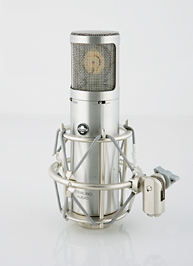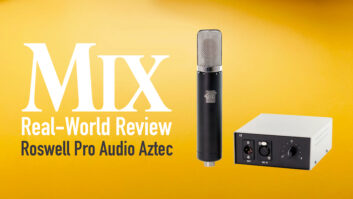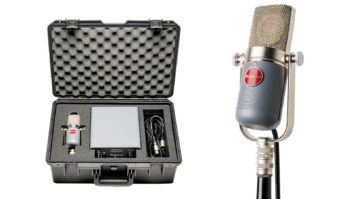
The mic’s Disk Resonator is visible under the mesh grille.
It would be far too easy to dismiss Sterling Audio as another “like all the rest” line of Chinese-made microphones. However, for several years now, Sterling Audio has carved its own niche, including developing a close connection with Groove Tubes founder Aspen Pittman, resulting in innovative products with affordable pricing and excellent performance.
Sold exclusively through Guitar Center-family companies — such as GC, GC Pro, Musician’s Friend and Music 123 — the Sterling Audio ST69 tube studio mic package includes the PSM1 power supply, 20-foot 7-conductor cable, shock-mount and aluminum transport case.
Bright Looks, Big Insides
The ST69 is a 7.5-inch, 1.2-pound condenser model with an attractive, machined stainless-steel body and brushed finish. Looks can be deceiving, so I was interested in what resided under the case. The electronics are an all-discrete, Class-A design with nice touches, such as high-end Wima capacitors and a large, custom-designed, nickel-core transformer with thick ferrite metal shielding. The miniature Groove Tubes GT6205 tube is shock-mounted on the underside of the board. Hand-selected for low noise, the 6205 is actually a pentode, but in this case it is wired to operate as a triode.
The ST69 has a 1-inch diameter, evaporated gold Mylar diaphragm with a thickness of just 3 microns. Protruding from the center of the diaphragm is a Disk Resonator™, a 1-centimeter-diameter brass disk resembling a donut shape. Raised above the level of the diaphragm, the disk acts like a Helmholtz resonator — essentially in the same manner as a loudspeaker whizzer cone, but in reverse. This preserves the sensitivity of the large capsule, while extending the capsule’s high-frequency response without resorting to equalization or other active filters.
Switches on the front of the mic body select a 10dB pad (for 140dB max SPL handling) and highpass filter (12dB/octave at 75 Hz), with a third switch on the backside for polar pattern (omni/cardioid/figure-8).
In Session
The ST69 rides high in the shock-mount, so the switches are easily accessible. The mic ships with an extra set of elastic cording for the shock-mount — a nice touch. I wasn’t wowed about the plastic angle-adjustment knob. This doesn’t have the same quality as the rest of the package, and its small size and close proximity to the shock-mount frame make it hard to tighten. There’s no non-shock-mount mounting clip, which limits placement somewhat, but this shouldn’t be an issue in most applications.
Once set up, I switched on the power supply and was greeted with a burst of warm-up hiss, which subsided after about 60 seconds as the tube warmed up and the electronics stabilized.
My first session was on a male vocal with the ST69 in cardioid. The cardioid pattern is fairly wide, with even, uncolored off-axis response. The mic’s gentle proximity effect provided a nice warmth around 200 Hz when used close in. The twin-layer mesh grille does a good job of handling breath noise when the source is kept at least four or five inches away, but for tighter work you’ll need an external pop shield. In cardioid, the mic had a smooth, mostly flat natural sound, with a slightly rising (+2dB) upper midrange boost around 5 to 8k Hz and extended HF “air” out well beyond 12 kHz. There was no need for EQ here, and I had the same experience in recording flute and acoustic guitar overdubs. The result was full and round with plenty of top articulation that made the tracks sound like the instrument in the room.
Used close-up in the figure-8 pattern, the ST69 has a huge proximity boost with a low-end pump that provided an instant Barry White effect on vocals and a great sound on acoustic bass. With extended HF reproduction and nearly identical front and back lobe response, the ST69 is an ideal candidate for M/S miking, as well.
In the omni pattern, the ST69 was very flat out to 10 kHz, followed by a slight bump around 12 kHz and plenty of high-end response. Combining a single ST69 above a kit (with an Audix D6 kick mic for punch) offered a drum sound that was natural and balanced.
One thing that surprised me somewhat was that the ST69 picks up everything. Used as an ambience mic 10 feet up on an AiRR Support boom, the ST69 had no problem reproducing distant piano bench squeaks, page turns, rattling drum hardware and air handling noise — a combination of wideband problems that other mics may have missed entirely.
With a low $599 street pricing, I was initially skeptical about the Sterling ST69. But it sounds great and would serve equally well in a large studio collection or as a single mic that can handle almost any recording application.








